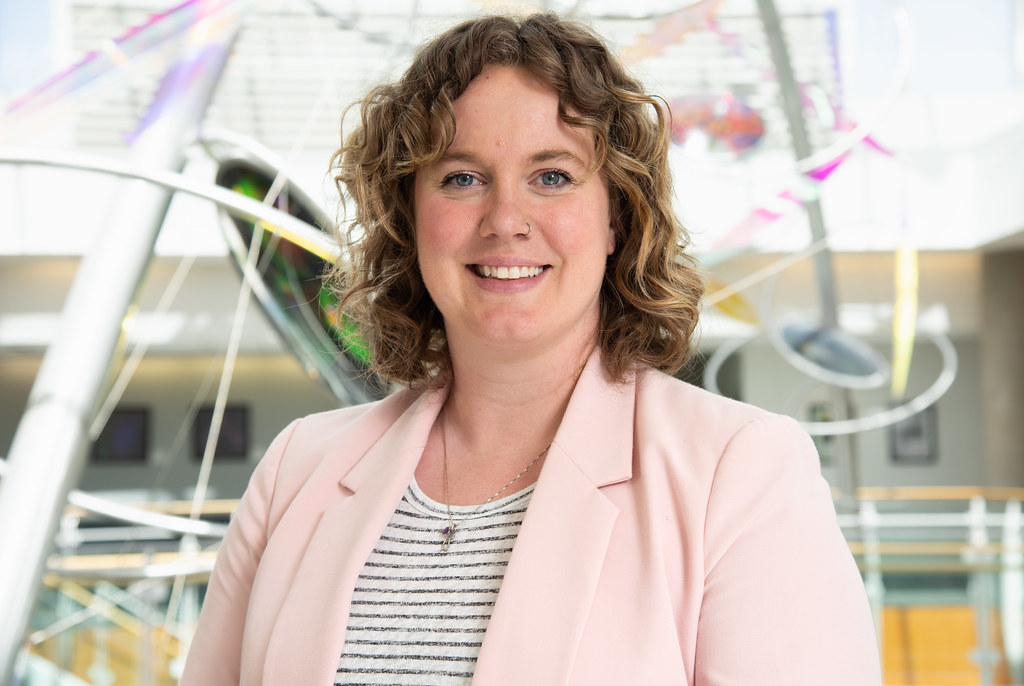Published on
By Sarah Gassel | Bond LSC
In the spring of 2009, Kim Jasmer, a swimmer from the University of Washington, arrived at the University of Missouri for the Missouri Grand Prix, one of a seven-meet series featuring elite swimmers from all over the world. Between swimming her own races and cheering on teammates, Jasmer had another important task on her agenda.
The athlete had scheduled a meeting with the now-retired Mizzou Professor of Biological Sciences, Steve Alexander, to discuss his work investigating genetic mechanisms underlying resistance to chemotherapeutics, topics quite far from her sport. The meeting began a long and sometimes winding road into research at Mizzou while allowing her to continue her swimming career, which ended after the 2012 Olympic Trials.
Jasmer, now an assistant research professor working with Bond LSC’s Gary Weisman, just made another important step down that path. She recently received her first National Institutes of Health (NIH) grant as the principal investigator. The two-year R03 award, which started in March, aims to uncover more information on an important receptor — the P2Y10 receptor — that could play a role in Sjögren’s disease.
“Grants are particularly fun because you get to dream up how you would answer a question,” said Jasmer. “I do like piecing everything together and the creativity of it.”
Sjögren’s disease is a common autoimmune disease that affects millions of Americans. The chronic condition — where immune cells attack and destroy the salivary and lacrimal glands that produce saliva and tears — mainly affects the eyes and mouth, though those with Sjögren’s have a wide range of symptoms.
Swimming in her own lane
Jasmer, who grew up in North Bend, Oregon, was following two of her passions — swimming and molecular and cellular biology — at the University of Washington when she saw Dr. Alexander’s work. She was interested in finding out how grad school at Mizzou could allow her to continue her passions, not just her studies.
“When I was looking at graduate schools, I wanted to keep swimming, so I looked at places where I could do both,” Jasmer said.
She started a biological sciences Ph.D. in 2009, and between hours doing laps and hours in the lab, Jasmer gained endurance in both. Her doctorate focused on cancer research, specifically looking at oxidative stress responses in melanoma, and after receiving the degree in 2015, she joined the lab of Michael Petris as a postdoc studying the influence of copper-dependent enzymes in the formation of tumors.
However, she was also interested in studying the immune system. In 2016, Gary Weisman’s lab — right across the hall from Michael Petris — received a grant for research on Sjögren’s disease and was looking for a postdoc to perform the studies. Knowing her interest in the subject, they approached her about the position. She accepted and began working half-time in each lab, eventually transitioning full-time to studying salivary glands.
“I didn’t start out intending to study salivary glands, but I landed in that community of researchers,” said Jasmer. “It’s a very small and supportive niche of scientists.”
The time since then has seen the Weisman lab learn more and more about the cellular workings of the disease, eventually leading to Jasmer submitting an R03.
The grant marked the first time Jasmer wrote and received an NIH grant independently. Although had previously written NIH grants collaboratively Weisman, this one was composed of her individual ideas, making the award all the more validating. Globally, NIH is the largest public funder of biomedical research, and the support an NIH grant provides can get a research project off the ground. But it is also highly competitive — on average, only about 20 percent of NIH grant applications are funded.
“I was kind of in shock because it feels like my career path has been so long, and there’s a lot of rejection that comes with it,” said Jasmer. “When one comes through and works out, it’s very exciting.”
The process of writing a grant is no easy feat, either. There are many questions that must be asked and answered when composing an application. It is not only necessary to propose what the research will potentially reveal but also the process needed to get this information, down to the techniques and analyses that will be used. Essentially, grant writing is akin to a much more complex and scientific version of the board game Clue.
Getting a spot on the podium
Recently, she’s seen her research make an impact in journals with her work being published in the Journal of Oral Biology and Craniofacial Research.
Currently, there are no curative therapies for Sjögren’s. Jasmer wants to eventually be able to apply her research to develop solutions. However, she says many questions must first be answered, and additional research must be done before reaching this goal.
“The downstream is that, if everything pans out, the P2Y10 receptor could be a great target, and we can work with the medicinal chemists to identify compounds that could target it and develop a therapy for Sjögren’s,” said Jasmer.
While this goal seems like a far way off, she has also come a long way through her leg of the relay so far.
Jasmer is an assistant research professor of biochemistry – CAFNR, working in the lab of Gary Weisman at Bond LSC. She recently published “Cell type-specific transforming growth factor-β (TGF-β) signaling in the regulation of salivary gland fibrosis and regeneration,” in the Journal of Oral Biology and Craniofacial Research.
